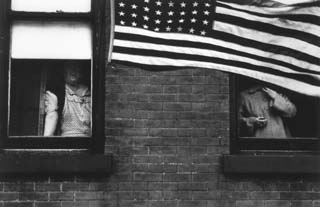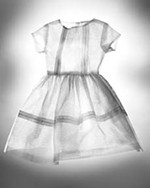His Shadow in the Frame
Robert Frank's photographs reveal his personal response to the world
By Erina Duganne, Fri., March 28, 2003

In 1954, with the help of a Guggenheim Fellowship, Swiss-born photographer Robert Frank embarked upon a journey across the United States that would change the nature of photography. Since that time, Frank, along with his book The Americans, has achieved almost mythic status, influencing generations of artists. Now Austinites have the unique opportunity to judge for themselves the impact of Frank's vision as it stands almost 40 years later.
For this Austin Museum of Art exhibition, Museum of Fine Arts, Houston curator Anne Wilkes Tucker delved into the museum's collection of 300 photographs by Frank and selected more than 60 prints that trace Frank's career from his photos of South America in the late 1940s to his images of Europe in the early 1950s to his influential views of America in the mid-Fifties, and finally, to the personal Polaroid prints of his family and homes in New York City and Nova Scotia in the 1970s and 1980s.
While this chronological arrangement serves as an excellent introduction to Frank's photographic practice, essentially laying out his development from the social documentary position early in his career to his more introspective work of the later decades, one can't help but wonder why Frank's production underwent such a drastic change. What led Frank to give up still photography in the early 1960s and devote his attention to filmmaking? And then to take up photography again in the Seventies, this time using multiple images and texts to address his subjective emotions, including the feelings of loss brought about by the death of close family and friends?
The AMOA exhibition never really answers those questions directly, but it's clear from the images here that whether Frank was working in still photography or film, whether his work was documentary in nature or personal, he was continually exploring his role as both participant and observer in the events recorded by his camera. For instance, in several images, Frank incorporates his shadow into the composition. While this self-referencing makes sense in his later "personal" photographs, its use in such documentary pictures as his 1955 Barbershop Through Screen Door, McClennanville, South Carolina and his 1958 Mary, Provincetown disrupts the seeming disjunction between his early and later works and attests to Frank's continued interest in looking both inside and out.

Whether using photography, film, or a combination of the two, throughout his career Frank has struggled to come to terms with how he might move beyond describing the world around him to reflect his personal and deeply emotional reaction to it. It is precisely his attempt to articulate a personal response that continues to make Frank and his work so appealing. ![]()
In conjunction with the exhibition of Frank's photographs, AMOA is sponsoring "Robert Frank and the Beat Generation," three evenings of film, music, and poetry highlighting works by Frank and his contemporaries. Curated by local filmmaker John Ausbrooks and the new media arts group al*limbic systems, the programs will include musicians Rick Reed, Josh Ronsen, Carl Smith, James Alexander, Matt Armistead, Robert Heine, and Jacob Green and poets Dale Smith, Hoa Nguyen, and Phillip Trussell as well as the following films:
On Thursday, April 3, 7:30pm, at the Alamo Drafthouse Downtown, 409 Colorado, the program will screen Frank's 1959 film Pull My Daisy, made with writers Jack Kerouac and Allen Ginsberg, and painters Alfred Leslie, Larry Rivers, and Alice Neel, on a program with the 1986 film Fire in the East: A Portrait of Robert Frank, by Phillip and Amy Brookman; The Wonder Ring and Mothlight, two color shorts by the late Stan Brakhage; and In the Street, a 1952 urban documentary by Helen Levitt.
On Thursday, April 10, 7:30pm, in Preece Recital Hall at the Austin Lyric Opera Music School, 901 Barton Springs Rd., the program will screen Frank's 1969 film Conversations in Vermont, chronicling his relationship with his children, Pablo and Andrea; Frank's 1981 documentary spoof Energy and How to Get It, featuring William Burroughs as the Energy Czar; and two films by Bruce Conner, A Movie and The White Rose.
On Thursday, April 24, 8pm, in Ceremony Hall at Sri Atmananda School, 4100 Red River, the program will screen two of Frank's works, the 1990 color video C'est Vrai and the 1999 memorial tribute Sanyu, along with two films by Bruce Conner, Vivian and Looking for Mushrooms.
Admission to each program is $7 ($5 AMOA members) and may be purchased at the door.
For information, call 495-9029 or visit www.amoa.org.
"Robert Frank Photographs: Selections From the Collection of the Museum of Fine Arts, Houston" is on view through May 4 at the Austin Museum of Art, 823 Congress.








